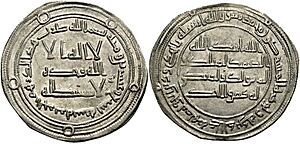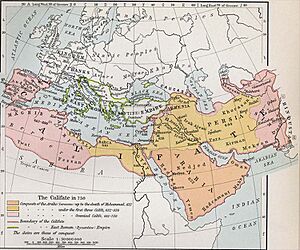Marwan II facts for kids
Quick facts for kids Marwan IIمروان بن محمد |
|||||
|---|---|---|---|---|---|
|
|||||

Dirham of Marwan II
|
|||||
| 14th Caliph of the Umayyad Caliphate | |||||
| Reign | 4 December 744 – 25 January 750 | ||||
| Predecessor | Ibrahim ibn al-Walid | ||||
| Successor | Position abolished al-Saffah (as Abbasid caliph) |
||||
| Born | c. 691 Al-Sham, Umayyad Caliphate (present-day Syria) |
||||
| Died | 6 August 750 CE (aged 59) Al-Misr, Umayyad Caliphate (present-day Egypt) |
||||
| Spouse | Muznah | ||||
| Issue |
|
||||
|
|||||
| House | Marwanid | ||||
| Dynasty | Umayya | ||||
| Father | Muhammad ibn Marwan | ||||
| Mother | Umm Marwan (Umm walad) |
||||
| Religion | Islam | ||||
Marwan ibn Muhammad ibn Marwan, known as Marwan II, was an important leader in Islamic history. He was the fourteenth and final caliph (ruler) of the Umayyad Caliphate. He ruled from 744 until his death in 750. His time as caliph was mostly spent dealing with a big civil war. He was the last Umayyad ruler to lead the united Caliphate before the Abbasid Revolution took over.
Contents
Early Life and Background
Marwan ibn Muhammad was born around 691 CE. He was part of the Marwanid family, a branch of the Umayyad dynasty. His father was Muhammad ibn Marwan. Muhammad was the son of Marwan I, who was the fourth Umayyad Caliph. This made Marwan's father a half-brother to Abd al-Malik ibn Marwan, another important Umayyad Caliph. Marwan's mother was known as Umm Marwan, which means "Mother of Marwan."
Becoming a Governor
In 732, when he was still young, Caliph Hisham chose Marwan to be the governor of Armenia. This was an important role. He led military campaigns in the region. In 735, Marwan invaded Georgia. He took control of several fortresses. He also made peace with local leaders. Later, in 739, he launched more raids. These actions helped him gain tribute, which was like a payment from conquered areas.
A Time of Trouble
In 744, Marwan heard about a plan to remove Caliph al-Walid II. He wrote to his family, telling them not to do it. He wanted them to keep the Umayyad rule stable. But his advice was not followed. Many armed men went to Damascus. Yazid III then took over as caliph. He removed al-Walid from power.
Marwan II had been in charge of battles against the Byzantines and the Khazars. These were on the northwestern borders of the Caliphate. After al-Walid II died, Marwan thought about becoming caliph himself. But a rebellion stopped him. Instead, Yazid III made him governor of Upper Mesopotamia. Marwan then moved to the city of Harran. He remained a governor during Yazid III's rule. He did not try to claim the throne for himself at that time.
Marwan II Becomes Caliph
When Yazid III removed al-Walid II, Marwan first disagreed. But then he accepted Yazid as caliph. Yazid III died soon after. He had named his brother Ibrahim ibn al-Walid as his successor. But Marwan still wanted to be caliph. He ignored Ibrahim and became the new caliph. Ibrahim at first hid. Then he asked Marwan for safety. Marwan agreed. Ibrahim even went with the new caliph to a place called Rusafah.

Muslim state at the death of Muhammad Expansion under the Rashidun Caliphate Expansion under the Umayyad Caliphate
Marwan named his two sons, Ubaydallah and Abdullah, as his future heirs. He also appointed new governors. He worked to make his power strong. But many people were against the Umayyads. This was especially true in Iran and Iraq. The Abbasids had gained a lot of support. Because of this, Marwan's time as caliph was mostly spent trying to keep the Umayyad empire together.
Facing Rebellions
Marwan had to fight many rebellions. He captured Emesa (Homs) after a long siege. A group called the Kharijites, led by Al-Dahhak ibn Qays al-Shaybani, started a rebellion. They defeated Syrian forces and took Kufa. Sulayman ibn Hisham also turned against Marwan. But he was badly defeated. The Kharijites moved towards Mosul. They were defeated there. Sulayman then joined them.
The fighting continued. Marwan pursued his enemies to Mosul. He besieged them there for six months. With more soldiers, he drove them out. Shayban fled and was killed. Sulayman sailed to India.
The Abbasid Revolution
In Khurasan, there was also much conflict. The Umayyad governor, Nasr ibn Sayyar, faced opposition. Abbasid messengers arrived. There was a strong belief that the Abbasids would soon rise to power. In 747, the Abbasids officially started their revolt. Nasr sent his soldier Yazid against them. But Yazid was captured. He was impressed by the Abbasids. When he was released, he told Nasr he wanted to join them.
Fighting continued in Khurasan. The Abbasids kept gaining more power. Finally, Nasr became sick and died in 748.
Marwan went to Egypt in 749. He wanted to stop the Bashmuric Revolt and secure his position. But his campaign failed. Meanwhile, the Abbasids were winning in the Hijaz. Marwan suffered a major defeat by Abu al-Abbas al-Saffah at the Battle of the Zab. More than 300 members of the Umayyad family died in this battle.
Marwan fled. He left Damascus, Jordan, and Palestine. He reached Egypt, where he was caught and killed on August 6, 750. His sons, Ubaydallah and Abdallah, escaped to modern Eritrea. Abdallah died in fighting there.
Marwan's death marked the end of the Umayyad rule in the East. The Abbasids then killed almost the entire Umayyad family. Only one prince, Abd ar-Rahman I, escaped to Spain. He founded a new Umayyad dynasty there.
Physical Description
Marwan was known to have a fair complexion. He had blue eyes and a large beard. He was described as having a big head and being of medium height. He did not dye his beard, so it remained white.
See also
- Marwan ibn Muhammad's invasion of Georgia
- Battle of the Zab
- Muhammad ibn Marwan

